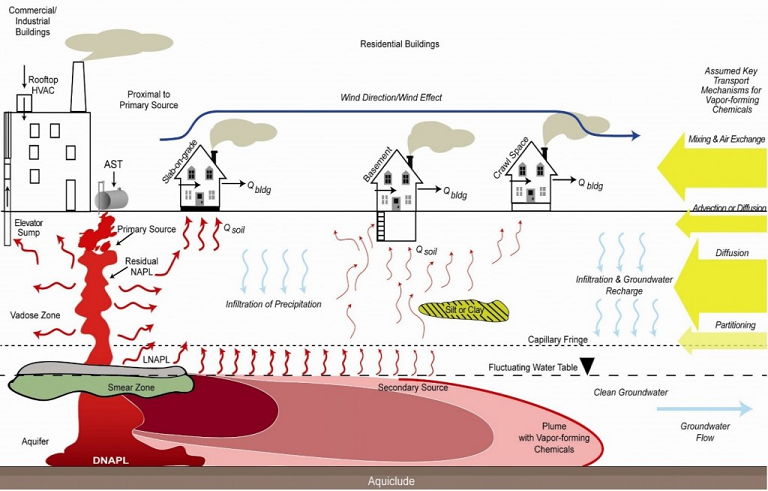TCE (trichloroethylene or trichloroethene), is not simply another acronym in the environmental consulting industry. It’s got a few others that could go along to help describe it: VOC (volatile organic compound), DNAPL (dense, non-aqueous phase liquid), and COC (constituent of concern). We’ll delve into some of these a bit more below.
A brief history of TCE
TCE was first produced in the United States circa 1925 and has had a variety of uses since that time such as, a solvent to decaffeinate coffee, surgical disinfectant, and as a general anesthetic. Luckily, the FDA banned the medical uses in 1977. TCE has been used, industrially, as an extraction solvent for greases, oils, fats, waxes, and tars. It has been used by the textile industry to scour cotton, wool, and other fabrics. TCE has been used in dry cleaning operations and as a component of adhesives, lubricants, paints, varnishes, paint strippers, refrigerants, pesticides, and cold metal cleaners. One of its main uses has been, and remains to be, as a metal degreaser in industrial applications.
The parent-daughter relationship
TCE is a man-made chemical, and there are no known naturally occurring sources. So, when it is referred to as a “parent-product”, that is how it was originally manufactured. It also exists as a break-down product, or daughter, of another chemical that we are all familiar with, tetrachloroethylene, which is also known as tetrachloroethylene, tetrachloroethene, perchloroethylene, perchloroethene, perc, or just simply PCE. Yes, another acronym.
Physical properties of TCE
Remember above, where it was referred to as a volatile organic compound or VOC? Generally, that means that it is a compound that easily becomes a vapor or a gas at atmospheric conditions. And the DNAPL part? That means that it has a density greater than water (about 1.46 times as dense as water to be precise), and it sinks in water. That’s one of the characteristics that makes this stuff, and other chlorinated solvents so difficult, interesting, frustrating, and persistent. When it is spilled on the surface, it will readily evaporate and disperse into the atmosphere. But as it seeps into the ground, it binds with soil particles, which slows or reduces its volatility. As it continues to migrate downward and encounters groundwater, its volatility is reduced even further.
Sources and Releases to the Environment
Major sources of TCE are from industrial facilities that use or have used TCE in their manufacturing process, and from dry cleaners that use or have used PCE as their main dry cleaning solvent. Historically, and before environmental regulations took effect, many industrial and commercial businesses utilized a “just dump it out back” mentality. This mindset, along with incidental drips, small spills, leaking pipes, and leaking chemical storage tanks can lead to long term sources of TCE in the environment. The following diagram generalizes how chemicals are released to the environment, and their behavior once a release has occurred.

From the USEPA OSWER Vapor Intrusion Technical Guide
Investigation, Remediation and Mitigation of Exposure
At the beginning of any project, Wilcox performs a comprehensive background check of the subject property to determine obvious or likely sources of the constituents of concern and from there, we develop a conceptual site model or CSM (yes, another acronym). The CSM is used to guide our investigation to help identify potentially complete routes of exposure which could lead to threats to human health and/or the environment. So, first we investigate to identify the problem, mitigate any complete exposure pathways, and then if the situation warrants, we remediate to eliminate the threat.
Health Effects of Routes of Exposure
Exposure to moderate amounts of TCE may cause headaches, dizziness, and sleepiness; large amounts may cause coma and even death. Eating or breathing high levels of TCE may damage some of the nerves in the face. Exposure to high levels can also result in changes in the rhythm of the heartbeat, liver damage, and evidence of kidney damage. Skin contact with concentrated solutions of trichloroethylene can cause skin rashes. The International Agency for Research on Cancer (IARC) and the EPA determined that there is convincing evidence that trichloroethylene exposure can cause kidney cancer. TCE is listed in the 13th Report on Carcinogens (RoC) as reasonably anticipated to be a human carcinogen. The National Toxicology Program (NTP) is recommending a change in cancer classification to “known human carcinogen.” https://www.atsdr.cdc.gov/toxfaqs/TF.asp?id=172&tid=30
Routes of exposure include: direct contact with TCE or contact with soil or water that has been impacted, ingestion typically from drinking TCE impacted water, and inhalation of vapors.
Wilcox and TCE
Wilcox scientists have a wide range of experience in characterizing and evaluating occurrences of TCE and other contaminants in the environment. Our specific experience includes sampling and analysis of soil, groundwater, indoor air, and subsurface vapors; calculation of exposure point concentrations for mitigation of exposure and remediating TCE-contaminated soil, groundwater and indoor air.
If you’d like assistance with assessing, investigating, managing, or mitigating risks related to TCE or other potential contaminants, have questions, or have a need for more acronyms, please contact me at (317) 472-0999 or sconnors@wilcoxenv.com.
